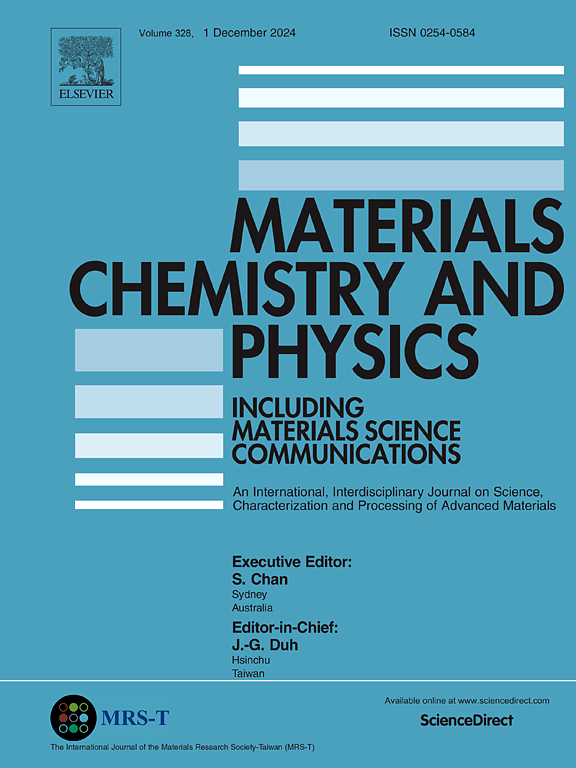基于 Lac 的锌铜混合金属氧化物纳米粒子的生物合成及其对交替孢霉和氧孢霉抗真菌活性的评估
IF 4.3
3区 材料科学
Q2 MATERIALS SCIENCE, MULTIDISCIPLINARY
引用次数: 0
摘要
使用动物来源进行生物合成与日益增长的可持续和生态友好型材料市场产生了共鸣,但与植物和微生物来源相比,动物来源的生物合成仍严重不足。在这一领域,从 Kerria lacca 昆虫中提取的生物树脂--虫胶,因其丰富的可获得性和抗微生物特性,正在成为纳米材料制造的理想候选材料。它通常以原种虫胶(SL)和加工后的钮扣虫胶(BL)的形式存在。因此,本研究考察了虫胶作为绿色制剂合成锌铜混合金属氧化物纳米粒子的潜力,以及合成的纳米粒子的抗真菌活性。使用钮扣漆(ZnCu(BL)O)和种子漆(ZnCu(SL)O)合成了两种类型的氧化锌铜纳米粒子,并使用粉末 X 射线衍射(PXRD)、傅立叶变换红外光谱(FTIR)和扫描电子显微镜-能量色散 X 射线(SEM-EDX)光谱等多种技术对它们进行了表征。PXRD 图谱证实了 ZnCuO NPs 晶体的六方菱面体结构。傅立叶变换红外光谱分析阐明了 MMO 纳米粒子合成过程中可能涉及的官能团的存在,559 cm-1 和 555 cm-1 处出现的条带表明 Zn-O 和 Cu-O 键的形成。利用 SEM-EDX 技术对 MMONPs 的形态和元素组成进行了检测,结果表明生物合成的 ZnCuO NPs 为球形团聚体,整个材料中 Zn、Cu、C 和 O 分布均匀。此外,还评估了合成的氮氧化物对 F. oxysporum 和 A. alternata 真菌病原体的抗真菌活性。结果发现,生物合成的纳米粒子对 F. oxysporum 和 A. alternata 都具有显著的杀真菌潜力。此外,抗真菌结果表明,与 ZnCuBL-(O) NPs 和化学合成的 ZnCu-O NPs 相比,ZnCuSL-(O) NPs 对这两种真菌菌株具有更高的抗真菌活性。因此,使用虫胶制备的 ZnCuSL-(O) NPs 和 ZnCuBL-(O) NPs 可被视为传统杀真菌剂的经济、环保型替代品。本文章由计算机程序翻译,如有差异,请以英文原文为准。

Lac-based-biosynthesis of zinc–copper mixed metal oxide nanoparticles and evaluation of their antifungal activity against A.alternata and F. oxysporum
The use of animal-based sources for biosynthesis resonates with the growing market for sustainable and eco-friendly materials, but remains severely unexplored in comparison to plant-based and microbial sources. In this purview, shellac, a bioresin obtained from the Kerria lacca insect, is emerging as an ideal candidate for nanomaterial fabrication due to its abundant availability and anti-microbial properties. It is commonly available in the form of raw seed lac, (SL) and in the processed button lac (BL) form. Therefore, in the current study, the potential of shellac as a green agent for the synthesis of zinc-copper mixed metal oxide nanoparticles, and the anti-fungal activitiy of synthesized nanoparticles was investigated. Two types of zinc copper oxide nanoparticles were synthesized using button lac (ZnCu(BL)O) and seed lac (ZnCu(SL)O), and they were characterised using various techniques such as Powder X-Ray Diffraction (PXRD), Fourier Transform Infrared spectroscopy (FTIR) and Scanning Electron Microscopy-Energy Dispersive X-Ray (SEM-EDX) spectroscopy. PXRD pattern confirmed the hexagonal wurtzite structure of crystalline ZnCuO NPs. FTIR analysis elucidated the presence of functional groups that were potentially involved in the synthesis of MMO nanoparticles, and the formation of Zn–O and Cu–O bonds was suggested by appearance of bands at 559 cm−1 and 555 cm−1. The morphology and elemental composition of the MMONPs were examined using SEM-EDX techniques that revealed the formation of biosynthesized ZnCuO NPs as spherical agglomerates having uniform distribution of Zn, Cu, C and O throughout the material. Further, the antifungal activity of synthesized NPs was evaluated against F. oxysporum and A. alternata fungal pathogens. It was found that the biosynthesized nanoparticles exhibited significant fungicidal potential against both F. oxysporum and A. alternata. Furthermore, the antifungal results indicated that ZnCuSL-(O) NPs exhibited higher antifungal activity against both fungal strains than ZnCuBL-(O) NPs and chemically synthesized ZnCu-O NPs. Thus, ZnCuSL-(O) NPs and ZnCuBL-(O) NPs prepared using shellac may be considered as cost-effective and eco-friendly substitutes over traditional fungicides.
求助全文
通过发布文献求助,成功后即可免费获取论文全文。
去求助
来源期刊

Materials Chemistry and Physics
工程技术-材料科学:综合
CiteScore
8.70
自引率
4.30%
发文量
1515
审稿时长
69 days
期刊介绍:
Materials Chemistry and Physics is devoted to short communications, full-length research papers and feature articles on interrelationships among structure, properties, processing and performance of materials. The Editors welcome manuscripts on thin films, surface and interface science, materials degradation and reliability, metallurgy, semiconductors and optoelectronic materials, fine ceramics, magnetics, superconductors, specialty polymers, nano-materials and composite materials.
 求助内容:
求助内容: 应助结果提醒方式:
应助结果提醒方式:


